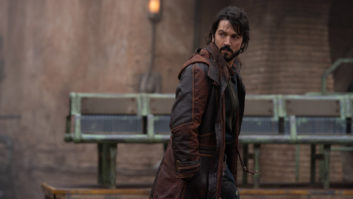
It’s time to recognise a shift within the industry that’s thrust us into a new golden age of TV says Canon’s Austin Freshwater (pictured).
Television has never looked so good. Scan the channels any given evening and you’re sure to see programmes that look more vivid and textured than in the past. Much of the video being produced for broadcast today has a filmic quality. It’s the result of a broad shift within the TV industry – the move to large sensor cameras.
Once limited to high-end, big-budget productions, large sensor cameras have become much more affordable in recent years, making them accessible for a wider variety of productions. “Large sensor cameras have become massively popular,” says Shaun Wilton of the UK equipment rental firm, Shooting Partners. “It’s because of a particular look – the shallow depth of field that was previously only available in drama with high budgets.”
When it comes to television production trends, rental houses are arguably the best bellwethers of what’s happening in the industry and why. Whereas big media organisations might be inclined to stick with legacy equipment because of sunk costs and established workflows, rental firms have an incentive to invest in the most sought-after cameras. They deal with a range of equipment from different manufacturers as well as the people using that equipment day to day, so they’re in an excellent position to judge how a camera’s performance delivers against its promise. The sentiment coming from these organisations today is that large sensor cameras have become an increasingly popular standard for many productions where quality matters but budget is still a consideration.
Danny Dawson, general manager of rental house, Alias Hire, agrees. “We are seeing a massive transition towards large sensor cameras. These days, most people are training themselves on DSLR technology so it’s the natural next step,” he says.
For skilled operators, these cameras offer new opportunities for creative expression. That said, the end-result isn’t easy to achieve and cameramen will need to adapt and embrace the challenges of the technology and form factor, in order to maintain focus when shooting with a narrow depth of field. While some less experienced users may find this a challenge, others are sure to relish the task and see it as an opportunity to reintroduce a level of expertise back into the craft. One thing’s for sure, the results are redefining TV output.
In the early days of our professional cine camera – the EOS C300 – some within the industry doubted the widespread appeal of large sensor cameras across different genres. We always knew that this type of technology would have a great place in dramas where there’s time to change lenses, but the reality is that we’ve seen these cameras being utilised in all kinds of productions. The results are so good that even primetime reality TV shows, where cameramen are expected to follow their subjects for long periods of time without breaking the action, are also employing these devices.
When lens changes are needed, the ability to employ a wide range of prime hardware removes the necessity of using more traditional zoom lenses, which can become cumbersome in certain scenarios. The ability to swap lenses at ease enables broadcast professionals to achieve the look they’re after without ever needing to compromise on quality.
However, there is still a demand within the industry to bring the familiar versatility of zoom lenses to the world of large sensor cameras. Dawson believes the recent introduction of cine-servo lenses represents the next breakthrough for broadcasters looking to utilise large-sensor camera technology alongside the optical precision of a cinema zoom. “A 17-120mm lens ticks so many boxes. What we’re looking to demonstrate is that you can get away from the cumbrous process to a more fluid style,” he says.
The most surprising aspect of the broadcast industry’s embrace of large sensor cameras isn’t how swift it’s been, how far reaching it’s become or the enthusiasm it’s generated – it’s that all of these things have happened at once, defying pretty much everyone’s expectations.







